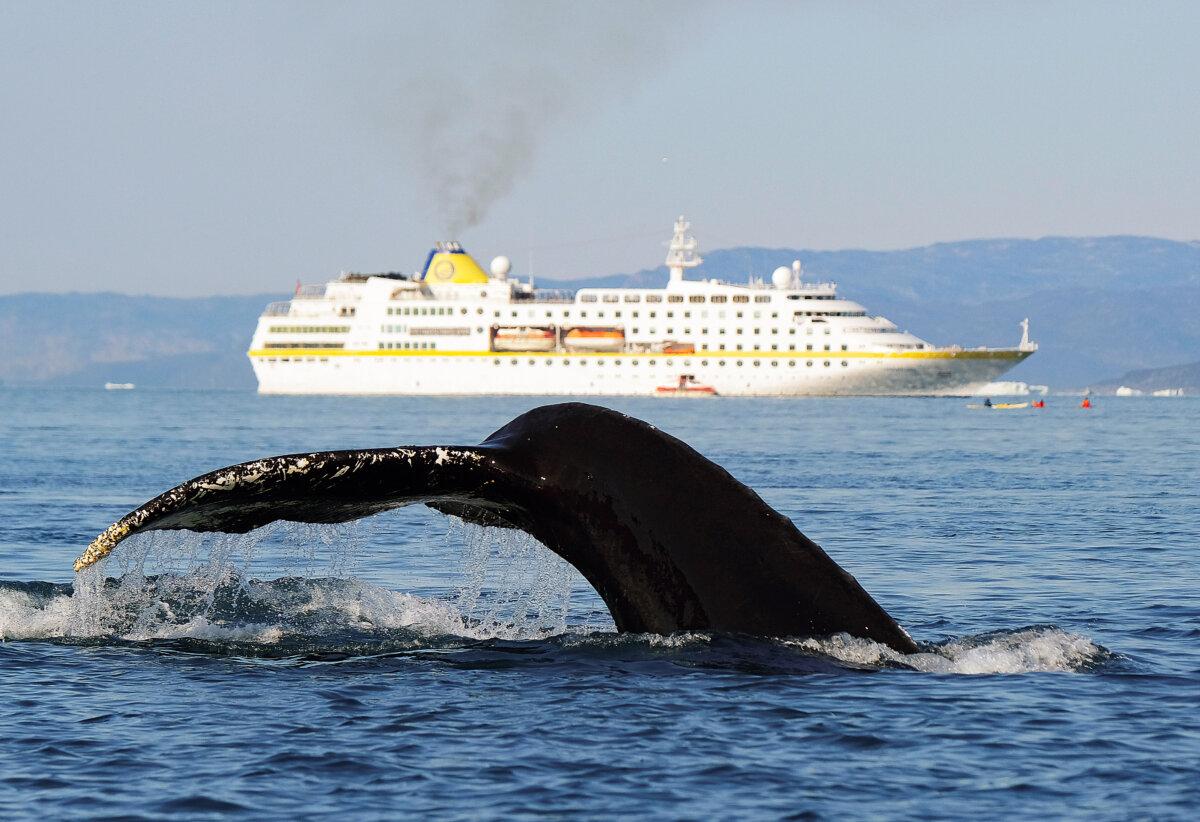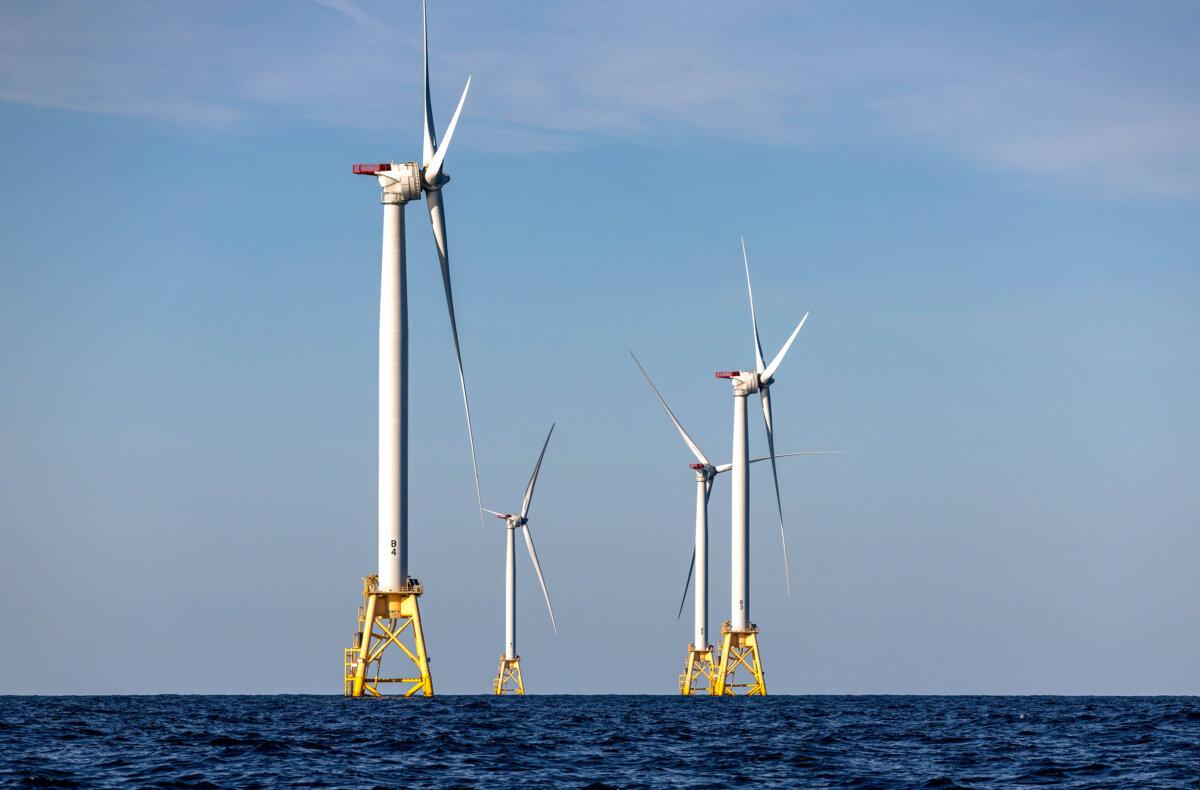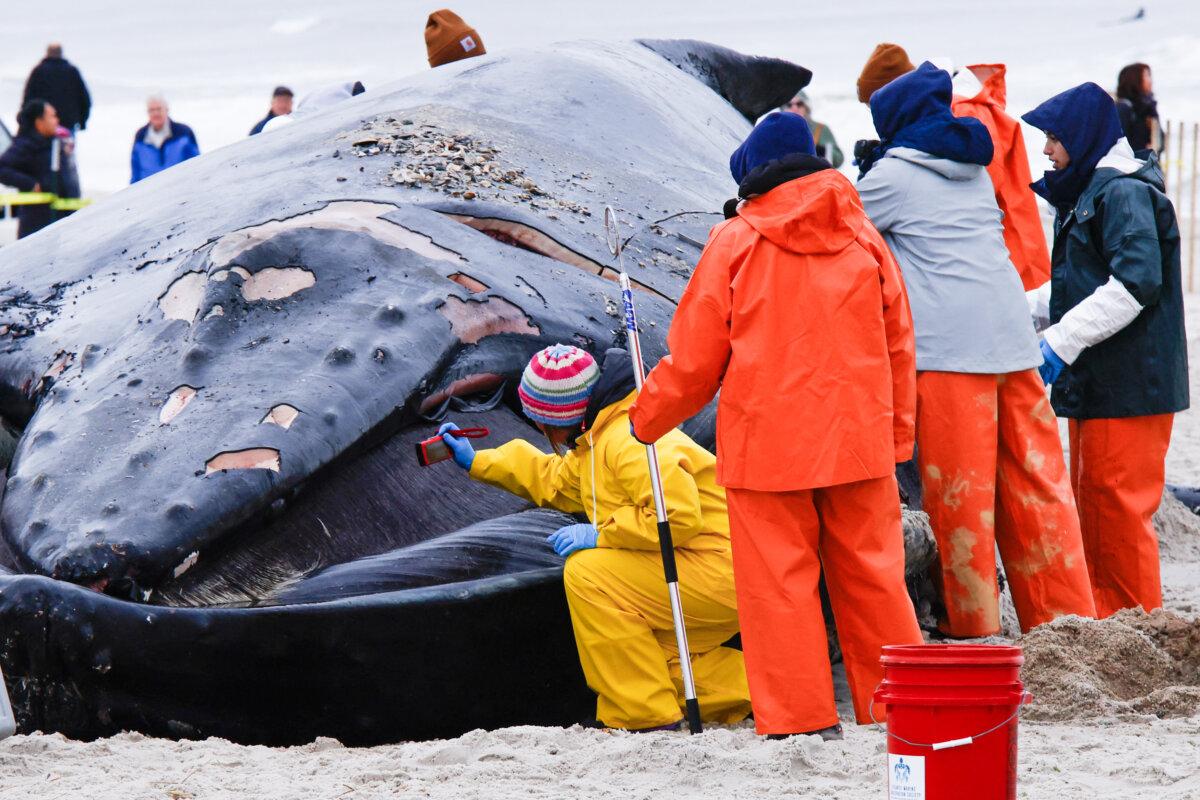
Former President Donald Trump said recently that “windmills are causing whales to die in numbers never seen before.”

Former President Donald Trump said recently that “windmills are causing whales to die in numbers never seen before.”
His comments, made at a campaign rally in South Carolina, were quickly ground through the fact-checking mills of legacy media outlets such as The Guardian and the BBC.
The BBC lamented that clips of the former president’s speech had exceeded 9 million views but that his “claims are not backed up by evidence.”
President Trump also said only one whale had been killed off the coast of South Carolina in the past 50 years, but now the numbers are increasing.

He said that there’s been no conclusive link between whale deaths and wind farms in the UK.
Andrew Read, commissioner of the U.S.-based Marine Mammal Commission, told The Guardian that “there’s no scientific evidence whatsoever that wind turbines, or surveying for wind turbines, is causing any whale deaths at all.”
Although there are broader concerns over industrializing the ocean, he said whale deaths are caused by vessel strikes, entanglement in fishing gear, and warming of the ocean caused by climate change.
“The population of humpback whales, in particular, is recovering from being hunted and they are coming closer to the coast to feed on prey, which means they are being hit as they come into shipping lanes, or being caught up in nets,” Mr. Read said.
He said people protesting ocean-based wind turbines are being manipulated by “fossil fuel interests,” who are threatened by so-called clean energy.
In August, the National Oceanic and Atmospheric Administration (NOAA) reported to The Epoch Times that there had been 65 large whale deaths along the East Coast since December 2022. Three dead whales washed ashore in one week in Fire Island, New York; Long Branch, New Jersey; and Long Beach, New York.
In September, the Biden administration released “An Action Plan for Offshore Wind Transmission Development in the U.S. Atlantic Region.”
President Joe Biden’s $3.5 billion goal is to deploy 30 gigawatts of offshore wind by 2030.
The plan is based on the “Atlantic Offshore Wind Transmission Study” to coordinate “timely transmission access for offshore wind” and to “evaluate multiple pathways to offshore wind goals.”
Ms. Linowes said the move is costing lives.
“Roughly 350 whales have died along the East Coast since 2016,” she said.
The uptick began in 2016, she said, with a slight dip in 2022.
“And in the first six months of 2023—so just half a year—roughly 40-plus whales have died,” Ms. Linowes said.
Currently, a total of 3,500 wind turbines are proposed for construction across 2.2 million acres of ocean along the East Coast.
High-resolution geophysical technology is used to survey the ocean floor for the future construction of these turbines. This seismic equipment is sending out frequencies that some believe are blasting the whales and dolphins with loud sounds that have resulted in their disorientation and inability to traverse the waters as safely as they had before.
Robert Rand, an environmental scientist, said the U.S. Bureau of Ocean Energy Management (BOEM) and NOAA haven’t accounted for the avoidance and aversion that takes place when the whales hear the pile driving and other dissonant sounds reverberating from the construction of the turbines.
“They don’t make the connection between a loud noise in the water and species moving away from that noise, and that’s a problem because they don’t have the fat stores to run around forever trying to get away from that noise,” Mr. Rand said in the film.
“If a calf is separated from the mother, what I understand is both of them start stressing a lot, and it doesn’t take long for them to die. It’s a very deadly situation. The calf needs the mother for food, and the mother is trying to find the calf.”
After the mother and calf expend their energy, they are stranded and they die, he said.
“What I’m seeing is troubling,” Mr. Rand said. “What I’m seeing are levels that are above the limit which NOAA itself set to be protected at distances which are much higher than were granted in the incidental harassment authorization. So, to me, it looks like an absolute breakdown of regulatory protection for the right whale.”
When it comes to oil and gas development, environmental groups such as Greenpeace and the Sierra Club will advocate for wildlife, Ms. Linowes said, but in the case of so-called renewable energy, they blame other factors such as ship strikes and climate change, or they keep silent.

In 2021, the National Marine Fisheries Service concluded that the Rice’s whale in the Gulf of Mexico was its own separate species, of which there remained only 50.
U.S. District Judge James Cain, appointed by President Trump, agreed and ordered NOAA to withdraw its proposal.
Environmental groups such as the Center for Biological Diversity advocated for the protection of the area, and the group has initiated several lawsuits arguing that offshore drilling is harming ocean wildlife; however, the organization has made no efforts to challenge the offshore wind development impact on whales.
On Sept. 28, the center filed an emergency petition asking that NOAA mandate speed limits for vessels.

“Right whales can’t withstand any more delay on protections, nor should they have to,” Kristen Monsell, oceans legal director at the Center for Biological Diversity, said in a statement.
“Even one ship strike would bring these whales closer to extinction, but speed limits can help prevent that. Federal officials can’t sit back and do nothing while right whales are in danger.”
The question that many locals along the East Coast continue to ask remains: Why have whales that have maneuvered their way through vessels for decades suddenly been unable to avoid ship strikes over the past few years?
In mid-September, Nantucket Residents Against Turbines (NRAT) filed an appeal for a case in which the organization alleges that several federal wildlife regulators failed to comply with the National Environmental Policy Act and the Endangered Species Act when “assessing, disclosing, and mitigating the environmental effects of its decision to approve the Vineyard Wind 1 offshore wind project, a project that consists of 62 wind turbines as high as the Statue of Liberty, with blades up to 300 feet long.”
NRAT said in the lawsuit that the defendants—BOEM, NOAA, and the National Marine Fisheries Service—are putting the ecosystem in “grave” danger.
“Perhaps even pushing at least one species—the North Atlantic Right Whale—to the point of extinction,” NRAT alleged.
The Vineyard Wind offshore wind project is slated for construction off the southern coast of Nantucket, Massachusetts.
Judge Talwani ruled that the group failed to show that the federal wildlife management departments had violated the National Environmental Policy Act or the Endangered Species Act in their impact statements on the project in 2021.
NRAT alleged in the lawsuit that both BOEM and NOAA failed to ensure that the project “would not jeopardize the survival of federally listed species, such as the North Atlantic Right Whale and to avoid jeopardizing the continued existence of such federally listed species.”
The North Atlantic right whale, according to NRAT, is an “iconic marine animal” that migrates along the East Coast.
“It is also one of the most imperiled species in the entire world, with fewer than 400 individuals known to exist in the wild,” NRAT said.
“Worse, the species is under constant threat from vessel strikes, entanglement in fishing gear, and loss of food sources, resulting in high mortality and low reproduction rates.”
NRAT said the area immediately south-southwest of Nantucket Island is a “longtime safe haven” for the whale.
“Unfortunately, this is the exact place that BOEM has selected for the purposes of constructing the largest offshore wind array ever assembled. The Vineyard Wind project is one—but only one—of the offshore wind projects proposed for this area,” the community group said.
NOAA has a network of organizations that investigate whale deaths.
Among those organizations is the Atlantic Marine Conservation Society, which, prior to 2021, consisted of several people committed to saving whales, according to Ms. Linowes.
Around 2021, that changed, with members of the board of directors also working for the wind energy company Equinor.
Atlantic Marine Conservation Society board president Paul Tonna is a lead lobbyist for Equinor, Ms. Linowes said, while board member Jennifer Dupont is a strategic environmental affairs manager at Equinor.
“About half the board of the Atlantic Marine Conservation Society appears to benefit from the development of offshore wind, and this is the organization responsible for investigating whale deaths that have been happening off the coast of New York,” she said.
The Epoch Times contacted the Atlantic Marine Conservation Society for comment.
In a 2022 letter to BOEM, NOAA’s chief of protected species Sean Hayes expressed concern over the development of offshore wind construction and its potential to harm marine life in southern New England waters, Ms. Linowes said.

The risks that Mr. Hayes listed included increased noise, vessel traffic, habitat destruction, and entanglement risks, as well as disruptions to the whale’s food source.
Though the risks can be “mitigated to some extent,” the “oceanographic impacts” from turbines operating over a period of 30 years can’t be mitigated “unless they are decommissioned,” Mr. Hayes said.
Despite alarm raised by multiple scientists, the concerns continue to be pigeonholed by media outlets and environmental groups as disinformation funded by pro-oil groups.
Mr. Van Drew shared the clip of President Trump on social media and said the number of whales that have become stranded along the Atlantic coast is “historic.”
“Why no investigations?” Mr. Van Drew asked on social media. “Why no environmental outrage? Why is the mainstream media silent?”
Source: Epoch Times
PRINCIPIA SCIENTIFIC INTERNATIONAL, legally registered in the UK as a company  incorporated for charitable purposes. Head Office: 27 Old Gloucester Street, London WC1N 3AX.
incorporated for charitable purposes. Head Office: 27 Old Gloucester Street, London WC1N 3AX.
Trackback from your site.
Howdy
| #
Yes, it is troubling, but as usual, the truth doesn’t play into the hands of the destroyers, so why bother? The planet is important until it’s not as important as another thing is.
Greenpeace are a laughing stock of hypocrites. Do as I say…
I hadn’t considered the frequencies used during sea bed surveys, but piling shock-sounds travel, and if I approach my pond, the impacts of my feet, even before I get close, the fish are feeling it.
On top of that is operational noise, which is found distressing to some people, so Heaven only knows what it does to water-life. Could it be possible it does drive the whales insane?
Reply
Dave
| #
The answer is 100% Yes!
Reply